9 Things Women with Great Skin Do Before and After a Workout
Prevent exercise-triggered skin problems before they start.
By Emma Haak

Photo: PixDeluxe/iStock/Getty Images Plus
Before the Gym:
Step 1: Throw this in your bag.
Chances are your gym isn't washing its towels in the gentle, fragrance-free laundry soap you use at home. So if you have sensitive skin, put a towel from home in your gym bag. Residue from commercial detergents (like those gyms often use) on towels can lead to irritation and even contact dermatitis, says Lisa Airan, MD, a board-certified dermatologist in New York. And when you use the towel, pat—don't rub—to minimize further irritation.
Chances are your gym isn't washing its towels in the gentle, fragrance-free laundry soap you use at home. So if you have sensitive skin, put a towel from home in your gym bag. Residue from commercial detergents (like those gyms often use) on towels can lead to irritation and even contact dermatitis, says Lisa Airan, MD, a board-certified dermatologist in New York. And when you use the towel, pat—don't rub—to minimize further irritation.
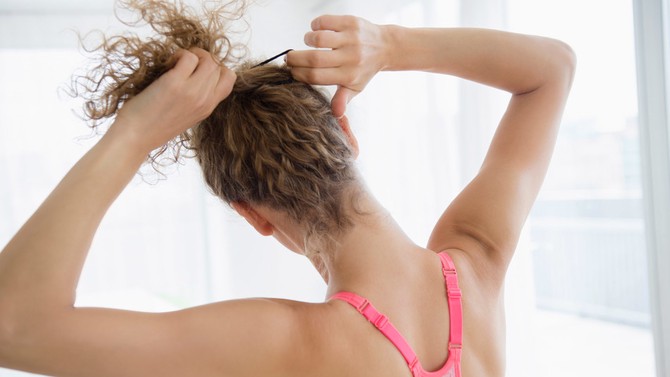
Photo: Scott Kleinman/Stone/Getty Images
Step 2: Put your hair up—but not too tight.
If you've got hair touching your face while you're working out, the natural oils (along with whatever styling products you've used) can trickle down onto your face when you sweat, says Joshua Zeichner, MD, assistant professor of dermatology at the Mount Sinai Medical Center, potentially clogging pores and causing breakouts. Pull hair up and back, but don't yank it back as tight as you possibly can—consistently putting your hair under that kind of tension can lead to traction alopecia, or thinning along the hairline. If you've got bangs, gently but securely pin them back and away from your forehead.
If you've got hair touching your face while you're working out, the natural oils (along with whatever styling products you've used) can trickle down onto your face when you sweat, says Joshua Zeichner, MD, assistant professor of dermatology at the Mount Sinai Medical Center, potentially clogging pores and causing breakouts. Pull hair up and back, but don't yank it back as tight as you possibly can—consistently putting your hair under that kind of tension can lead to traction alopecia, or thinning along the hairline. If you've got bangs, gently but securely pin them back and away from your forehead.
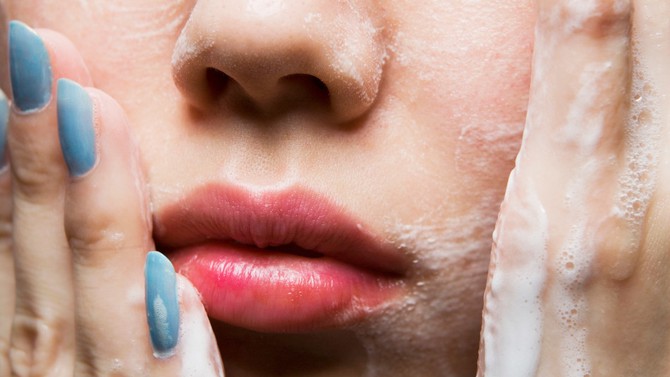
Photo: Debbi Smirnoff/E+/Getty Images
Step 3: Do the thing you don't have time for.
You're just going to sweat off your makeup anyway. You're self-conscious about going barefaced at the gym. Your class fills up so fast you don't have a second to remove your makeup. Ask any dermatologist and they'll tell you that whatever your excuse, washing your face before exercise is non-negotiable. If you work out with makeup on—even just a little bit—it could lead to clogged pores and breakouts. Light makeup can be removed with a towelette or wipe, but if you've got liquid foundation on or other heavy formulas, you need the strength of an actual cleanser to make sure it's all off before you begin your workout, Zeichner says.
You're just going to sweat off your makeup anyway. You're self-conscious about going barefaced at the gym. Your class fills up so fast you don't have a second to remove your makeup. Ask any dermatologist and they'll tell you that whatever your excuse, washing your face before exercise is non-negotiable. If you work out with makeup on—even just a little bit—it could lead to clogged pores and breakouts. Light makeup can be removed with a towelette or wipe, but if you've got liquid foundation on or other heavy formulas, you need the strength of an actual cleanser to make sure it's all off before you begin your workout, Zeichner says.
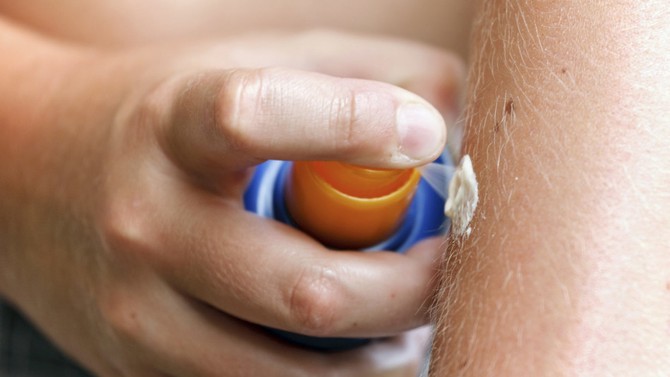
Photo: Jaap2/iStock/Getty Images Plus
Step 4: Apply SPF even if you're not going to step foot outside.
If you're exercising outside while the sun is up, you obviously need sun protection. But if you work out in a sun-drenched gym or your favorite piece of equipment happens to be the one next to the window, you need SPF too. UVB rays, the main cause of sunburn, can't penetrate glass, but at least 50 percent of UVA rays, which contribute to significant sun damage and skin cancer, can. Pick a broad-spectrum water-resistant or sweat-proof formula and apply it 15 minutes before you start working out so your skin has time to absorb it.
If you're exercising outside while the sun is up, you obviously need sun protection. But if you work out in a sun-drenched gym or your favorite piece of equipment happens to be the one next to the window, you need SPF too. UVB rays, the main cause of sunburn, can't penetrate glass, but at least 50 percent of UVA rays, which contribute to significant sun damage and skin cancer, can. Pick a broad-spectrum water-resistant or sweat-proof formula and apply it 15 minutes before you start working out so your skin has time to absorb it.
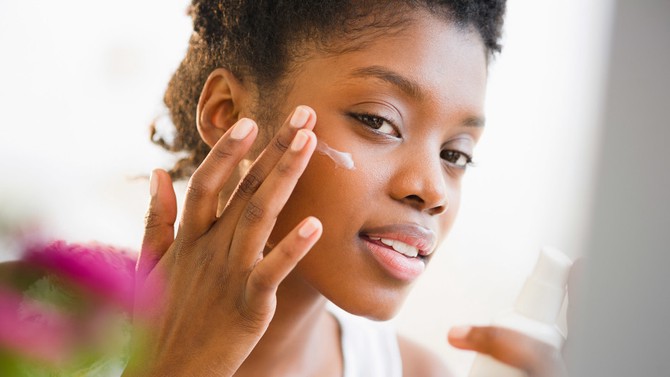
Photo: JGI/Jamie Grill/Blend Images/Getty Images
Step 5: Shield yourself from that other element.
There's one more item in the face-protection kit. Running, walking or biking into the wind doesn't just make your workout feel so much harder—it can worsen rosacea and irritate dry skin, says Ellen Marmur, MD, an associate clinical professor in both the Department of Dermatology and the Department of Genetics & Genomic Research at the Mount Sinai Medical Center. She recommends applying a waxy sunscreen or moisturizer to your face to create a non-irritating protective barrier between your skin and those gusts.
There's one more item in the face-protection kit. Running, walking or biking into the wind doesn't just make your workout feel so much harder—it can worsen rosacea and irritate dry skin, says Ellen Marmur, MD, an associate clinical professor in both the Department of Dermatology and the Department of Genetics & Genomic Research at the Mount Sinai Medical Center. She recommends applying a waxy sunscreen or moisturizer to your face to create a non-irritating protective barrier between your skin and those gusts.
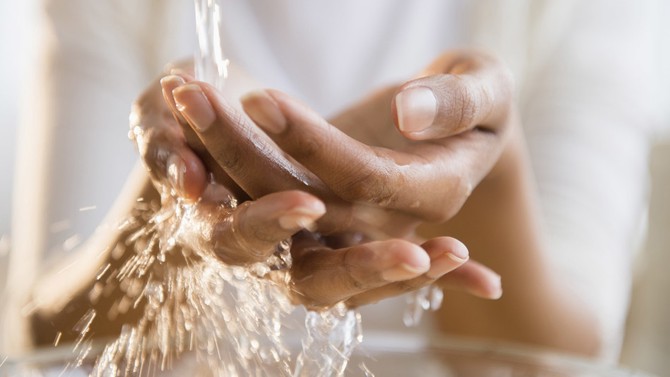
Photo: JGI/Jamie Grill/Blend Images/Getty Images
After the Gym:
Step 1: Don't touch this until you've done this.
Gym equipment can have sweat, dirt, oils and germs on it, and touching your face before you've thoroughly washed your hands can transfer those substances. The grime can clog your pores, and while the germs won't necessarily damage your skin, they could make you sick—63 percent of gym equipment tested positive for viruses (particularly the rhinovirus) in a study in the Clinical Journal of Sports Medicine. Airan had a patient who contracted the MRSA bacteria (which causes staph) at the gym after touching an open cyst on her lip during her workout. While most gyms aren't likely teeming with MRSA—a 2011 study tested for it at three gyms and found no trace, suggesting it isn't as widespread as once thought—Airan wears weightlifting gloves during her workouts to minimize calluses and keep germs off her hands.
Gym equipment can have sweat, dirt, oils and germs on it, and touching your face before you've thoroughly washed your hands can transfer those substances. The grime can clog your pores, and while the germs won't necessarily damage your skin, they could make you sick—63 percent of gym equipment tested positive for viruses (particularly the rhinovirus) in a study in the Clinical Journal of Sports Medicine. Airan had a patient who contracted the MRSA bacteria (which causes staph) at the gym after touching an open cyst on her lip during her workout. While most gyms aren't likely teeming with MRSA—a 2011 study tested for it at three gyms and found no trace, suggesting it isn't as widespread as once thought—Airan wears weightlifting gloves during her workouts to minimize calluses and keep germs off her hands.
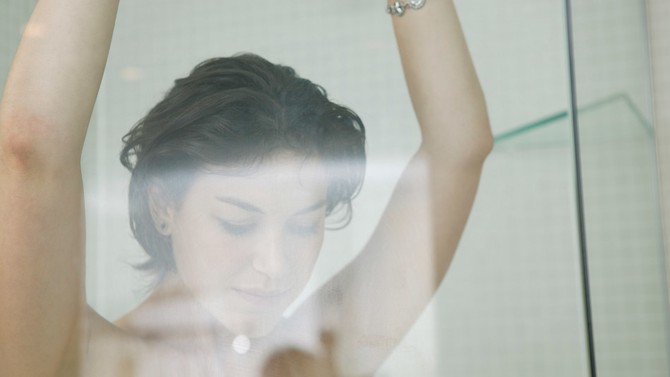
Photo: Shioguchi/The Image Bank/Getty Images
Step 2: Get out of those sweaty clothes.
Say it with us: "I will stop going from the gym to run my errands in my workout gear." Leaving sweat-saturated clothes on can cause acne and folliculitis, inflammation of the hair follicles (it looks like breakouts or ingrown hairs). "I see so many patients with folliculitis on their butt or chest, and when I ask them about their habits, it turns out they're wearing their workout clothes all day," Airan says. "That wouldn't happen if they'd just take a quick shower and change." If you're not going to shower and change at the gym, head straight home and hit your own shower—no stopping at the grocery store and the pharmacy along the way or lounging on the couch for a bit once you get home.
Say it with us: "I will stop going from the gym to run my errands in my workout gear." Leaving sweat-saturated clothes on can cause acne and folliculitis, inflammation of the hair follicles (it looks like breakouts or ingrown hairs). "I see so many patients with folliculitis on their butt or chest, and when I ask them about their habits, it turns out they're wearing their workout clothes all day," Airan says. "That wouldn't happen if they'd just take a quick shower and change." If you're not going to shower and change at the gym, head straight home and hit your own shower—no stopping at the grocery store and the pharmacy along the way or lounging on the couch for a bit once you get home.
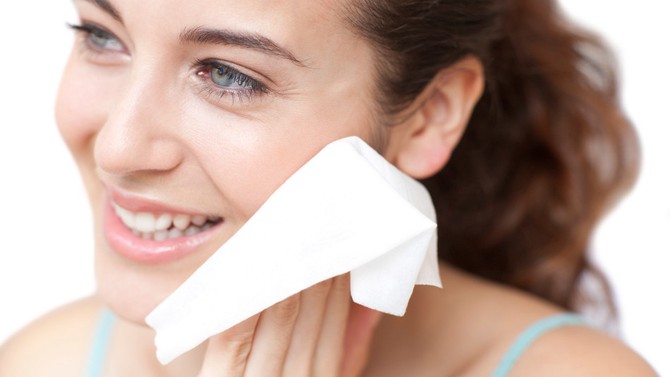
Photo: Ian Hooton/Science Photo Librart/Getty Images Plus
Step 3: Clean your face again.
If you did a thorough job of getting your makeup off before your workout, using a towellete or wipe after is enough to remove any sweat, dirt and oil that's on your face. Wiping after a workout will help keep pores from clogging.
If you did a thorough job of getting your makeup off before your workout, using a towellete or wipe after is enough to remove any sweat, dirt and oil that's on your face. Wiping after a workout will help keep pores from clogging.
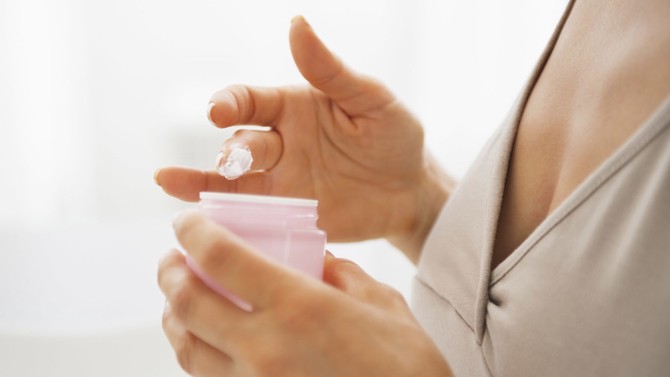
Photo: Alliance/iStock/Getty Images Plus
Step 4: Bring skin back to baseline.
Once you're showered and clean, deal with rosacea or redness by choosing a calming, anti-inflammatory or redness relief product. For dry skin, try an ultra-hydrating hyaluronic acid serum. And if acne is your concern, apply a topical salicylic acid product to help clear pores.
Once you're showered and clean, deal with rosacea or redness by choosing a calming, anti-inflammatory or redness relief product. For dry skin, try an ultra-hydrating hyaluronic acid serum. And if acne is your concern, apply a topical salicylic acid product to help clear pores.
Published 05/26/2015
As a reminder, always consult your doctor for medical advice and treatment before starting any program.

